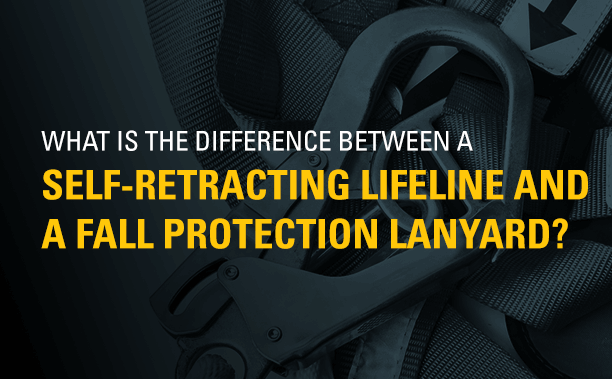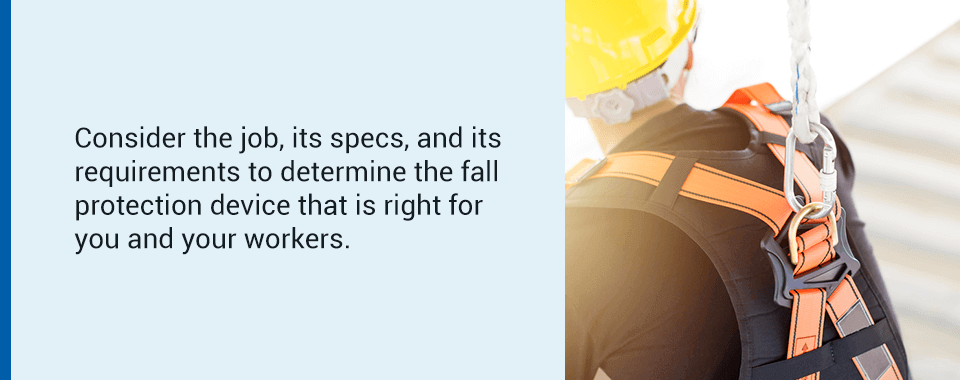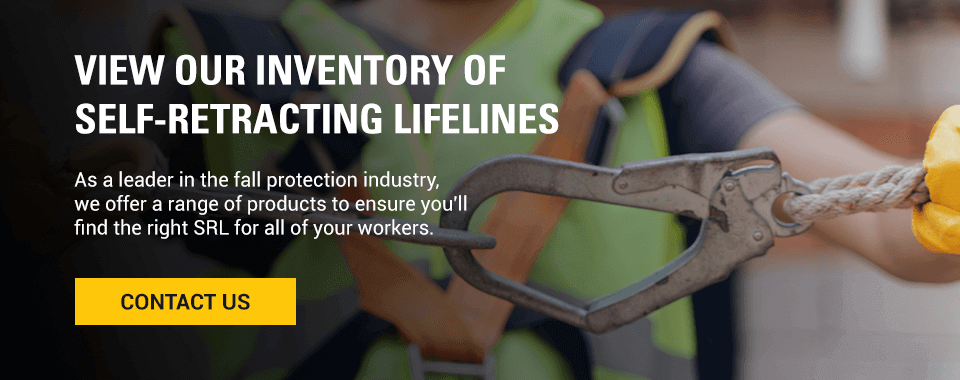
What Is the Difference between a Self-Retracting Lifeline and a Fall Protection Lanyard?
November 17, 2020
Construction sites and manufacturing plants can be hectic, with large teams of workers carrying out different tasks. Everyone is doing their part to get the job done. As a business owner, you know the importance of high productivity on each of your jobsites. But more than that, you care about your employees’ safety throughout every step of the process.
When your crew is working at height, they are at a greater risk of falling and sustaining injuries. Ensuring compliance with OSHA safety standards keeps them safer and more confident as they work. Self-retracting lifelines (SRLs) and fall protection lanyards are two devices that help keep your workers safer and OSHA-compliant.
Fall Arrest vs. Fall Restraint
There are two categories of fall protection devices — fall arrest and fall restraint. The term “fall arrest” refers to a series of devices that, when used correctly, stop a worker from falling if they slip or have a misstep while working from a height of several feet. Every fall arrest system requires the following three components.
- Anchorage: An immovable point of attachment
- Body support: Could be a full-body harness or similar safety item
- Connection: The device that joins the body support to the anchor point
“Fall restraint” keeps workers from falling by limiting their radius of work. Fall restraint systems can be anything from a set length of rope or cable to guardrails or barriers that keep workers within a set space.
What Are Fall Protection Lanyards?
Fall protection lanyards, also known as safety lanyards, can exist under either category of fall protection. They often consist of rope, webbing, or cable and are usually used in shorter lengths. As energy-absorbing lanyards, they connect a worker’s harness to an anchor point and stop their fall during a fall event.
Due to their typically short length, they can be used for fall restraint applications. Workers can keep a safe distance from the edge of their workspace using the lanyard’s set distance. Fall protection lanyards can also be used for work-positioning purposes, such as leading-edge work.
How Are Self-Retracting Lifelines Different?
Like fall protection lanyards, self-retracting lifelines consist of webbing or wire rope. They serve as the connection between a worker’s body support and an anchor point, and their lengths vary depending on the job requirements. Like seat belts, they automatically retract into an overhead housing unit.
If a worker falls, an SRL will use an internal braking mechanism to slow their body to a complete stop. This safety feature also mimics a seat belt’s ability to stop unwinding during sudden and sharp movements.
Which Option Is Right for You?
One choice is not intrinsically better than the other — it depends on your needs. Both carry out their unique function, and various projects call for different fall protection devices. Consider the job, its specs, and its requirements to determine the fall protection device that is right for you and your workers.

When to Use Fall Protection Lanyards
If the fall hazard can be avoided by work positioning or fall restraint, then fall protection lanyards can be the perfect solution to keep your workers safer on the jobsite. Plus, fall protection lanyards are usually less expensive than SRLs, making them a budget-friendly safety option.
Since fall protection lanyards use a free-hanging rope or cable, they keep workers within a set radius, so your workers can have peace of mind knowing they can work without approaching any ledges or workplace hazards.
When to Use Self-Retracting Lifelines
If the application requires active fall protection, then SRLS could be ideal for your specific worksite. SRLs provide shorter fall distances compared to energy-absorbing lanyards. During a fall event, the SRL’s internal braking mechanism will ensure the worker comes to a stop.
SRLs are a great option when the anchor point is overhead. Overhead anchor points keep the workspace clear of connections that could cause tripping and help keep the connection directly above the worker’s head, which helps prevent swing fall.
View Our Inventory of Self-Retracting Lifelines
If your jobsite requires self-retracting lifelines to keep your crew safer and more secure, Rigid Lifelines is here to help. Our inventory of self-retracting lifelines is great for applications where the attachment point is overhead. Compatible with our Rigid Lifelines overhead fall protection systems, our SRLs feature lightweight, high-impact resistant polymer or aluminum casings that can house our galvanized cable in lengths from 20 to 50 feet. As a leader in the fall protection industry, we offer a range of products to ensure you’ll find the right SRL for all of your workers.

Categories
Share this post
Let us help you
Contact us today to find the perfect product fit for your job
